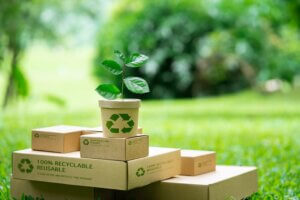
How to Reduce Your Carbon Footprint with Smarter Packaging Choices
In the face of growing environmental concerns, reducing one’s carbon footprint has become a priority for businesses and consumers alike. Packaging, often overlooked, plays a significant role in this effort. From the materials used to the design and lifecycle of packaging products, smarter choices can lead to substantial environmental benefits. This article explores how individuals and businesses can reduce their carbon footprint through smarter packaging decisions.
The Environmental Impact of Packaging
Packaging contributes to carbon emissions at every stage of its lifecycle: raw material extraction, manufacturing, transportation, usage, and disposal. Traditional packaging materials like plastics, although lightweight, are derived from fossil fuels and can persist in the environment for hundreds of years. Similarly, inefficient packaging designs can lead to increased waste and higher transportation emissions due to excessive weight or volume.
Choosing Sustainable Materials
The first step in reducing your carbon footprint through packaging is selecting sustainable materials. Opt for materials that are:
- Recyclable: Materials like paper, cardboard, glass, and certain plastics can be recycled multiple times, reducing the need for virgin resources.
- Biodegradable or Compostable: Packaging made from organic materials such as cornstarch, mushroom mycelium, or biodegradable plastics breaks down naturally, lessening environmental pollution.
- Recycled Content: Using recycled materials reduces the demand for new raw materials and the energy required for production.
Innovative Packaging Solutions
Innovation in packaging design also contributes to sustainability. Consider the following strategies:
- Minimalist Design: Reduce material usage by eliminating unnecessary layers and components.
- Lightweight Packaging: Lighter packaging reduces transportation emissions and energy costs.
- Modular and Stackable Designs: These optimize space during transportation and storage, leading to fewer trips and reduced fuel consumption.
- Edible Packaging: Emerging technologies are producing edible packaging, which not only eliminates waste but also offers unique marketing opportunities.
Reusable Packaging Systems
Another effective way to minimize environmental impact is by adopting reusable packaging systems. This approach is particularly beneficial for businesses that manage logistics and supply chains. Reusable packaging reduces waste, conserves resources, and often results in cost savings over time.
Efficient Supply Chain Practices
Smarter packaging isn’t just about the materials; it’s also about optimizing the supply chain:
- Consolidated Shipments: Reducing the number of shipments can significantly cut carbon emissions.
- Local Sourcing: Procuring packaging materials from local suppliers reduces transportation distances.
- Eco-Friendly Transportation: Partner with logistics companies that use fuel-efficient or electric vehicles.
The Role of Businesses and Consumers
Businesses play a pivotal role in driving sustainable packaging practices. Companies like Brandt Box, for example, are pioneering efforts to provide eco-friendly packaging solutions tailored to the needs of modern commerce. By choosing suppliers committed to sustainability, businesses can make a significant impact.
Consumers also hold power through their purchasing choices. Supporting brands that prioritize sustainable packaging encourages more companies to adopt environmentally friendly practices.
Regulatory and Certification Standards
Many regions are implementing regulations to reduce packaging waste and promote recycling. Familiarizing yourself with standards like:
- ISO 14001: Focuses on environmental management systems.
- Forest Stewardship Council (FSC) Certification: Ensures paper products come from responsibly managed forests.
- Cradle to Cradle Certification: Evaluates products for environmental and social sustainability.
These certifications help identify genuinely sustainable packaging options.
Practical Tips for Reducing Packaging Waste
- Bulk Packaging: Reduces the amount of packaging needed per unit.
- Digital Receipts: Eliminates the need for printed receipts.
- Proper Recycling: Educate yourself on local recycling guidelines to ensure materials are processed correctly.
The Future of Sustainable Packaging
As technology advances, the future of sustainable packaging looks promising. Innovations in biodegradable plastics, smart packaging that reduces spoilage, and materials science are paving the way for even greener solutions. Companies investing in research and development are likely to take charge of a more sustainable future.
Reducing your carbon footprint through smarter packaging choices requires a multifaceted approach. By selecting sustainable materials, adopting innovative designs, optimizing supply chains, and supporting eco-conscious businesses, both companies and consumers can contribute to a healthier planet. As awareness grows and technology evolves, the shift towards sustainable packaging will become not just a choice but a necessity for environmental stewardship.